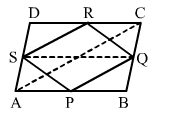$P, Q, R, S$ are respectively the midpoints of the sides $A B, B C, C D$ and $D A$ of $\|$ gm $A B C D$. Show that $P Q R S$ is a parallelogram and also show that $\operatorname{ar}(\| \operatorname{gm} P Q R S)=\frac{1}{2} \times \operatorname{ar}(\| \operatorname{gm} A B C D)$.

Given: ABCD is a parallelogram and P, Q, R and S are the midpoints of sides AB, BC, CD and DA, respectively.
To prove: ar(parallelogram $P Q R S)=\frac{1}{2} \times$ ar (parallelogram $A B C D$ )
Proof:
In $\triangle A B C, P Q \| A C$ and $P Q=\frac{1}{2} \times A C$ [ By midpoint theorem]
Again, in ∆DAC, the points S and R are the mid points of AD and DC, respectively.
$\therefore \mathrm{SR} \| A C$ and $\mathrm{SR}=\frac{1}{2} \times A C$ [ By midpoint theorem]
Now, PQ || AC and SR || AC
⇒ PQ || SR
Also, $P Q=S R=\frac{1}{2} \times A C$
∴ PQ || SR and PQ = SR
Hence, PQRS is a parallelogram.
Now, ar(parallelogram PQRS) = ar(∆PSQ) + ar(∆SRQ) ...(i)
also, ar(parallelogram ABCD) = ar(parallelogram ABQS) + ar(parallelogram SQCD) ...(ii)
∆PSQ and parallelogram ABQS are on the same base and between the same parallel lines.
So, $\operatorname{ar}(\triangle P S Q)=\frac{1}{2} \times \operatorname{ar}($ parallelogram $A B Q S)$ ...(iii)
Similarly, ∆SRQ and parallelogram SQCD are on the same base and between the same parallel lines.
So, $\operatorname{ar}(\Delta S R Q)=\frac{1}{2} \times \operatorname{ar}($ parallelogram $S Q C D)$ ..(iv)
Putting the values from (iii) and (iv) in (i), we get:
$\operatorname{ar}($ parallelogram $P Q R S)=\frac{1}{2} \times \operatorname{ar}($ parallelogram $A B Q S)+\frac{1}{2} \times \operatorname{ar}($ parallelogram $S Q C D)$
From (ii), we get:
$\operatorname{ar}($ parallelogram $P Q R S)=\frac{1}{2} \times \operatorname{ar}($ parallelogram $A B C D)$
